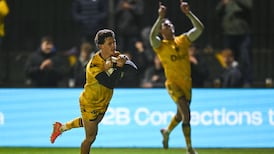New research has revealed how angel shark stocks have declined alarmingly in Irish waters, according to Inland Fisheries Ireland (IFI). The study, published in the journal Endangered Species Research, includes long-term data which shows how stocks crashed in the late 1990s and remain severely depleted today.
An analysis of angling data over a 40-year period at two hotspots in Irish waters – Tralee Bay and Clew Bay – reveals a sharp decline of at least 95 per cent over the last 25 years.
Since 2000, only 20 angel sharks have been recorded by IFI, with just one caught since 2011. This compares to an average of 65 tagged annually in Ireland by charter boat skippers at their peak in the 1980s.
0 of 4
Between 1958 and 2016, a total of 1,261 were recorded, with most of the fish (85 per cent) captured in Tralee Bay and a further 9 per cent in Clew Bay. The data for these historical hotspots are significant to international conservation efforts.
While angel shark were common in waters from Scotland to North Africa, they are susceptible to capture in commercial fishing gear. Their large size, slow reproductive cycle and tendency to live on the seabed mean they are vulnerable to capture.
Since the 1970s, scientists have been co-ordinating the tagging of sharks and rays caught on Irish recreational angling boats. The Marine Tagging Programme distributes numbered tags to skippers along with information and a logbook, while the Irish Specimen Fish Committee co-ordinates the collection of information of specimen fish caught in Irish waters.
Dr William Roche, the study’s co-author and a senior research officer at IFI, said: “Our analysis shows that catches have declined to almost zero in both Tralee Bay and Clew Bay. However, there is still some hope for angel shark in Ireland, as there have been anecdotal sightings of the fish in recent years.”
Visit Endangered Species Research to read the full article
Students make the transition to anglers
The annual visit of transition year students from St James’s CBS, Dublin 8 to the K Club in Straffan, Co Kildare for a fishing outing took place recently at the kind invitation of estate fisheries manager John O’Neill. The occasion was part of the students’ course on the introduction to angling.
Following on from last year’s visit, where students concentrated on pike fishing with great success (six pike were caught ranging from 18lb to 27lb), this year the emphasis switched to fly fishing for rainbow trout.
With most of the 27 lakes on the estate stocked with a variety of fish ranging from carp, pike, bream and rainbow and brown trout, this year two of the trout lakes were utilised with reasonable success. Barbless hooks ensured many failed to make the net.
The K Club has a policy whereby all wildlife are left to their own devices and roam freely within the estate, and that includes mink.
“I have adopted a pet fox [named Frederika] which sits beside me most days while I’m fishing,” O’Neill said.
The outing was the culmination of a series of talks, fly-tying and visits to sea, coarse and game fisheries, organised by Ciarán Ward and his back-up team, to enlighten TY students in the sport of fishing.
Special mention is extended to fisheries stalwarts Josie Mahon and Des Chew and fellow officers, who provided the necessary sponsorship and hands-on assistance on the day. Their help and advice was invaluable to the students.
Fishing rates are €65 per person plus €50 ghillie (two additional anglers €65 each). About three hours’ duration. For booking, call +353-1-6017200.
Emotional farewell to Annie
An emotional gathering in Wicklow harbour recently witnessed the official retirement of the RNLI Tyne-class lifeboat after 30 years’ service at the town’s lifeboat station. During that period, the Annie Blaker launched more than 348 times on call-outs and rescued 408 people.
The lifeboat will be replaced by a faster class capable of up to 25 knots. The Tyne class could reach just 18 knots at full speed.
The Annie Blaker travelled on to Portishead, near Bristol, where she was sold privately and is replaced by the relief Shannon-class lifeboat Jock and Annie Slater.
Wicklow RNLI operations manager Des Davitt said: “I want to pay a special thanks to our station mechanic Brendan Copeland who looked after Annie so well for all these years. Her incredible life-saving record is a measure of how well she was maintained.”
Guide to River Moy fishery in East Mayo launched
East Mayo Anglers’ Association (EMAA) has launched a most informative guide to its fishery on the river Moy. With over nine miles of fishing water, the EMAA stretch of water incorporates some of the finest fly fishing runs and natural holding pools on the system.
The guide sets the scene with a synopsis of the club’s history dating back to the late 1940s, and moves forward to today with the construction of a 70-metre fishing stand for anglers with disabilities at a cost of €200,000.
Two of the highlights in the guide are the inclusion of nine full-page maps showing 94 pools from below Cloongullane Bridge at the lowest point to the Old Schoolhouse, close to Foxford. Each map provides best practice on how to catch a salmon.
The second inclusion relates to tackle tips, remembering all the while that club rules allow for spinner, worming and fly on designated areas. Shrimp and prawn baits are strictly prohibited.
Courtesy of artwork supplied by tackle dealer Tiernan Brothers of Foxford, the guide details tackle tips plus diagrams for worm rig (float), bubble and fly rig, worm rig (ledger) and spinner spoon rig. This information will be invaluable to the visiting angler.
An Angler’s Guide to East Mayo Anglers’ Association Fishery on the River Moy is available by emailing eastmayoanglers@eircom.net or tel: +353 (0) 94-9253955. Price €5.
angling@irishtimes.com
derekvevans@gmail.com














